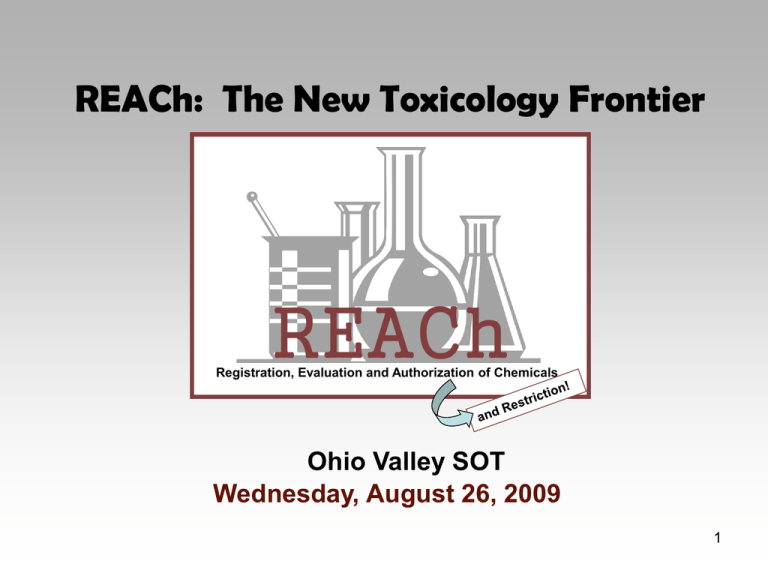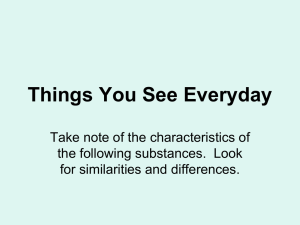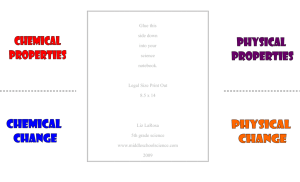REACh REACh: The New Toxicology Frontier Ohio Valley SOT
advertisement

REACh: The New Toxicology Frontier REACh Registration, Evaluation and Authorization of Chemicals Ohio Valley SOT Wednesday, August 26, 2009 1 Presenters Jennifer Galvin, PhD, DABT, CIH Manager, Industrial Hygiene & Toxicology ConocoPhillips Tracy Hammon, MS, DABT Director, Product Safety ConocoPhillips 2 Overview • • • • • • • • • What is REACh? Why REACh? Goals of REACh Impacts of REACh General Information Information Requirements Technical Dossier Chemical Safety Report Extended SDS 3 What is REACh? • New EU Chemicals Regulation • REACh : Registration, Evaluation, Authorization and Restriction of Chemicals • REACh replaces 40 existing EU Chemical Regulations and Directives 4 Stages of REACh • Pre-registration: by December 2008 • Registration: for substances ≥ 1 ton/yr • Evaluation: for high volume substances which are of highest concern • Authorization: only for substances of highest concern • Restriction: the Safety net The European Chemicals Agency (ECHA) was established to manage the system 5 REACh Timeline http://guidance.echa.europa.eu/docs/guidance_document/nutshell_guidance.pdf 6 Why REACh? • Lack of knowledge about chemical hazards on the EU market. • Prior legislation was regarded as slow & burdensome. • Incomplete information on existing chemicals vs. new chemicals. • The burden of proof was on regulators. 7 Goals of REACh • Enhance transparency and efficiency • Close data gaps between existing & new substances. • Manage and control potential hazards and risks to human health and the environment from the manufacture, import and use of chemicals within the EU 8 Impacts of REACh • REACh is a global business issue that will drive major changes in the way chemical businesses are organized • REACh has the potential to be a major threat to supply chain continuity • Clear and decisive leadership and management is needed 9 Businesses need to understand how valuable these substances are to them, and plan to make effective business decisions based on this knowledge. Decisions made today will impact future business practices 10 No data = No market 11 REACh is a substance-specific regulation PRODUCT 12 Product A D G B C E F This product contains 8 substances Therefore, this product will require 8 registrations H 13 Multiple Expert Requirements • • • • • • • • • • • • • lawyers lobbyists communicators IT-specialists regulatory experts physicians Toxicologists hygienists researchers process engineers purchasers & logistics marketing network Export/Import coordinators 14 Impacts of REACh • Burden of proof has shifted to industry • Industry will have to prepare a comprehensive document including: – Hazards – Risks – Risk management 15 Classification & Labeling • Under the new Global Harmonized System – Each substance will be required to undergo classification • Under REACh, this classification will be documented in the registration dossier 16 Identified Uses • Use of the substance must be included in the registration • If substance is hazardous, exposures need to be assessed 17 REACh Phases Pre-Registration SIEF Formation Registration Evaluation Authorization Restriction 18 Pre-Registration • Phase-in Substances • Pre-registration deadline December 2008 • Approx. 143,000 existing substances were pre-registered – ECHA received about fifteen times more preregistrations than expected 19 SIEF • Substance Information Exchange Forum • Purpose: – Data sharing (compulsory) – Agreement on Classification and Labeling 20 Registration • Substances > 1 ton/year • Develop Technical Dossier – Reduced requirements for intermediates • Chemical Safety Assessment • Classification 21 Technical Dossier • Required for registration • Information requirements – dependent on tonnage band • Contents: – Information on manufacture & use of substance – Physical characteristics, toxicological & ecotoxicological properties – Proposals for testing if appropriate – Indication of information submitted that should not be made available on internet & why 22 Proposals for testing….if appropriate This is not a regulation that requires testing 1. 2. 3. 4. Provide the data available Do the risk assessment Determine data gaps Drive testing requirements 23 Source: http://www.api.org/ehs/health/upload/API_REACH_Guide.pdf 24 All Substances >1 ton/year Physical Tox/Ecotox Requirements Source: http://www.api.org/ehs/health/upload/API_REACH_Guide.pdf 25 + 10 - 100 tons/year Source: http://www.api.org/ehs/health/upload/API_REACH_Guide.pdf 26 + 100 - 1000 tons/year Source: http://www.api.org/ehs/health/upload/API_REACH_Guide.pdf 27 + > 1000 tons/year Source: http://www.api.org/ehs/health/upload/API_REACH_Guide.pdf 28 Evaluation • Substances > 10 tons/year • Chemical Safety Assessment • Requires detailed Chemical Safety Report – Required if a substance is dangerous, PBT or a vPvB – Risk characterization on exposures from intended uses – Risk Characterization 29 Chemical Safety Assessment • Safety (physico-chemical) • Human health • Evaluate data • Classification and labelling • Establish Derived No-Effect Level (DNEL) • Environmental • Evaluate data • Classification and labelling • Establish Predicted No-Effect Concentration (PNEC) 30 DNELs and PNECs • DNEL: Derived No Effect Level • PNEC: Predicted No Effect Concentration 31 Exposure Scenarios • Manufacture and intended uses – • • • substance life cycle (including disposal/recycling) Include • processes and tasks • frequency and duration (how often and how long?) • operational conditions • representative exposure data or modelling data • What risk management measures are required? For each human population exposed – Workers – Consumers – Indirect Included as an appendix to the Safety Data Sheet (SDS) – Now called an Extended Safety Data Sheet (eSDS) 32 Risk Management Measures • Must address workers, consumers, and the general public • For workers, consider… • Hierarchy of control • Principles of Good Control Practice (COSHH) • All routes of exposure (e.g., inhalation, dermal, ingestion) • Determine residual risk • Risk Characterization – compare exposure with the relevant DNEL 33 Environmental Assessment PBT Persistent, Bioaccumulative & Toxic vPvB very Persistent & very Bioaccumulative 34 Extended Safety Data Sheet (eSDS) • Used to communicate hazard down the supply chain • Increased requirements compared to current EU standard • Exposure scenarios 35 Authorization • Required for all substances of very high concern • Approx. 1,500-2,000 substances • Time limited • Substances of very high concern are: • • • • CMR (Carcinogen, Mutagen or Toxic for Reproduction Cat.1 or 2) PBT (Persistent & Bioaccumulative & Toxic) or vPvB (Very Persistent & Very Bioaccumulative & Toxic) substances of equivalent level of concern • Applicants must • demonstrate adequate control of risks or that socio-economic benefits outweigh risks • develop substitution plans or inform on research to find alternatives • Restrictions can be applied to any substance 36 Conclusion • Global Impact of REACh – US – TSCA Reform – China – ROHS – Taiwan – Canada The Fall-Out 37 38





